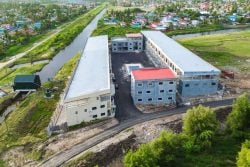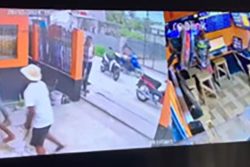Not for the first time, a major discovery of cocaine on land here has raised serious questions about control over the vast hinterland and whether the authorities are doing enough to gain ground on traffickers.
On Sunday, in separate statements, the Customs Anti-Narcotic Unit (CANU) and the Ministry of Home Affairs announced that 4.4 tonnes of cocaine had been found in four makeshift bunkers about 30 minutes from an illegal airstrip. Several of the minders of the cocaine had melted away into the dense jungle.
Given the very sensitive state of relations with Venezuela at this point, the last thing that this country needs is to have cross-border narco operations involving planes landing on illegal strips. That is an unwanted complication that could be exploited in various ways.
Instead of this nebulous defence institute that was launched on Wednesday, what the Commander-in-Chief of the Armed Forces should be investing oil resources in is vastly improved capabilities to determine what is happening in the skies of the hinterland and below the thick canopy.
The President must seek the best advice possible on radar acquisition, satellite imagery and drone utilization along all parts of the Guyana-Venezuela frontier. There has been mighty little talk of such acquisitions. The US’ National Aeronautics and Space Administration’s planned launch with India of the NISAR satellite, which would be able peer through the canopy, could provide an option next year and Brazil’s space research centre, INPE does have wide satellite reach.
As in previous major cocaine discoveries, it is important that the public be given all of the unclassified information and that there is evidence of a robust investigation to uncover any local ties to this network. This was not the garden variety of cocaine operations. A haul of 4.4 tons positioned in bunkers and packaged the way it was is the hallmark of one of the Colombian cartels so the authorities have a formidable adversary who may not be dissuaded from further operations.
How long did this operation transpire before the US DEA and CANU became aware of it? If the drugs did land at an illegal airstrip 30 minutes away from the bunkers it would have taken significant manpower and mobility to offload the drugs, transport it, excavate the bunkers and camouflage them. There were some signs in the camp area that there were periods of long stay. Was this the first operation of its kind from these bunkers or had it been done before? Was this operation undisturbed for several weeks? A month? Or longer? This operation would not have been very far from inhabited areas. How could it have gone on for any length of time without the authorities being tipped off?
Was the cocaine to be transported on a semi-submersible to its final destination? There has been evidence of semi-submersibles in Guyana’s waters. As recent as April this year, the Guyana Police Force discovered a semi-submersible vessel in Paiana Creek in Port Kaituma River, North West District. When searched, 15 sandbags along with six cases of water were discovered. The vessel was hidden beneath troolie leaves. A makeshift camp hidden from public view was discovered nearby. These are all telltale signs of terrestrial transshipping to sea-going craft.
So if the cocaine was to be transported through the jungle to the sea that would have entailed further planning and manpower and the carving out of a new route requiring finance, the hiring of various service providers and the risking of exposure. It remains highly plausible that such an operation had been successful before.
Not having apprehended any of the persons in proximity to the bunkers, the authorities don’t have much to work with save and except for an individual who was held several days ago. Whether or not that person was involved it is hardly likely, given the rules of the trade, that there will be much to learn. The authorities just need to be better prepared for the next time there is an intrusion of this type.
Indeed, Home Affairs Minister Robeson Benn emphasized the importance of local co-operation in combating drug trafficking and urged more residents of the area to assist law enforcement. “The people who live in the forest can join up in this fight because this is a fight for everyone,” Minister Benn told reporters on the scene, according to a statement from his ministry. For that to happen, the people who might possibly co-operate need to see that they will be supported and defended by a corruption-free security system which acts against serious transgressors and doesn’t cover up. There have been too many other cocaine operations where the law enforcement authorities were either inept or compromised.
In the case of Matthews Ridge, CANU saw the need to explain that the police had been kept abreast of what was happening.
“Contrary to reports circulating in the public domain, the Director of the Customs Anti-Narcotic Unit (CANU) Mr. James Singh, informed the Commissioner of Police, Mr. Clifton Hicken, and other Senior Police Officers that an operation was ongoing in Region One (1) area.
“The Commissioner of Police proceeded to offer his support to the ongoing operation if needed. CANU being a part of Joint Services, enjoys a close working relationship with all sister agencies and regularly conducts joint operations and information sharing with these agencies. CANU remains resolute in the fight against drug trafficking in Guyana and will continue to pursue its mandate and support other sister agencies”, a statement from CANU said.
This Matthews Ridge case will be another test of whether citizens will find assurance in the outcome of the investigation or simply be fed the customary line that the trail has gone cold and that no one can be held accountable.




